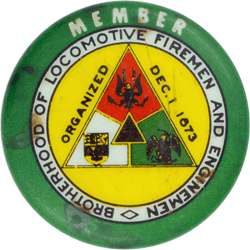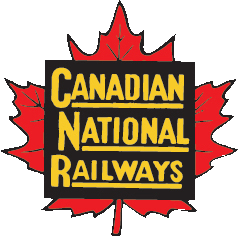 |  Article |

Prior to the use of diesel locomotives American railroads there was never any question about the use of a fireman in the cab of locomotives. It had always been assumed that a locomotive could not be operated without both an engineer and a fireman. When the diesel engines were first used in road service in the early 1930's however, only one man, an engineer, was used on the engine. A number of early diesel passenger trains ran up considerable mileage while being operated by an engineer without assistance from a fireman. It was the position of the carriers that firemen were not equipped either by training or by experience to supervise and to make adjustments to the diesel power-plant of locomotives.
The first significant controversy over the employment of a fireman on a diesel locomotive occurred in 1935 on the Chicago Burlington & Quincy Railroad (CB&Q). After a threatened strike by the Brotherhood of Locomotive Firemen, an agreement was reached with the CB&Q, calling for a fireman to be employed to help the engineer on diesel stream-lined passenger trains.1 This agreement appears to have broken the pattern of using diesel locomotives with only an engineer, and during 1935 and early 1936 many individual railroads made agreements stipulating that a fireman-helper was to be employed on passenger diesels. The use of diesels grew rapidly and by late 1936 they were being used by many roads for freight service and in switching. The Brotherhood of Locomotive Firemen was not satisfied with the use of helpers on only passenger diesels, and on 31 October 1936, the union presented a request to the carriers seeking a change in their respective agreements to provide for the placing of a fireman or helper on all types of power in road, yard, and other classes of service.
The result of the negotiations that followed was the so-called National Diesel-Electric Agreement of 28 February 1937, which provided the following:
1. Effective 15 March 1937 a fireman (helper) taken from the ranks of the Firemen shall be employed on the following locomotives used in road or yard service:
- (a) Diesel-electric, oil-electric, gasoline-electric, other internal combustion, or steam-electric, on stream-lined or mainline through passenger trains;
- (b) Diesel-electric, oil-electric, gasoline-electric, other internal combustion, steam-electric, all electric, of more than 90,000 pounds weight on drivers.2
In view of the fact that a majority of the diesel engines in use at the time already exceeded 90,000 pounds weight on drivers, the limitation in subsection (b) was of minor consequence. At the time the agreement was made, it was estimated that the application of its provision would add approximately US$445,000 to the annual payroll costs of the railroads which were parties thereto.3 The Firemen, in their journal, estimated that "...the operation of this agreement will mean the employment of some 700 additional firemen or helpers on locomotives that are now being operated with one man".4
In 1943 and again in 1948, the Brotherhood of Locomotive Engineers and the Brotherhood of Locomotive Firemen each made a request for an additional man from its own ranks to be used on multiple diesel units. The emergency boards that were created to hear these cases denied the requests made by the unions.
In the 1948 case the emergency board made a careful analysis of all claims made by the Firemen for a second fireman on all diesel locomotives. The board's report stated:
Upon careful analysis of the data submitted on safety, we have concluded that no valid reason has been shown as a support for the Brotherhood proposal under which a fireman should be required to be at all times continuously in the cab of all road diesels. This proposal must be rejected.5
With respect to the safety aspect of a Firemen's demand for an additional fireman in the engine room, the board commented as follows:
In view of the infrequency of crankcase explosions and fires, especially those which cause accidents, and of the certainty that an additional fireman could do little or nothing to avert a significant proportion of these crank case explosions which do occur, the claim for an additional fireman on road diesels as an appropriate remedy for the difficulties under discussion is devoid of merit.6

In 1956 the railroads for the first time attempted to seize the initiative in collective bargaining by proposing that the diesel rule in agreements be changed so that the use of firemen in passenger, as well as in freight and yard service, should be at the discretion of management. As part of the settlement for a three-year agreement, which included a moratorium on changes in working rules, this proposal was withdrawn. In Canada, however, a similar dispute arose when the Canadian Pacific Railway, early in 1956, proposed to the Brotherhood of Locomotive Firemen that the employment of firemen on diesel locomotives in freight and yard service be dispensed with. Here, however, the issue was not withdrawn.

In April 1956 the Canadian dispute came to a head, and the conciliation board established to resolve the dispute gave its report in December of the same year. The company accepted the findings and recommendations of the conciliation board, but the Brotherhood of Locomotive Firemen did not. Subsequent negotiations between the parties failed, and a brief work stoppage occurred in January 1957. The strike ended
occurred in January 1957. The strike ended when the parties agreed to the establishment of a Royal Commission to investigate and report on the matters in dispute, and to renegotiate those parts of their collective agreements in the light of the commission's advisory report. The chairman of this three-man commission was R.L. Kellock, and the commission is generally referred to as the Kellock Commission
when the parties agreed to the establishment of a Royal Commission to investigate and report on the matters in dispute, and to renegotiate those parts of their collective agreements in the light of the commission's advisory report. The chairman of this three-man commission was R.L. Kellock, and the commission is generally referred to as the Kellock Commission .
.
The Kellock Commission was appointed to inquire into and report on all matters it deemed necessary in order to answer the following questions:
- (a) Are firemen (or firemen helpers) required on diesel locomotives in freight and yard service on the Canadian Pacific Railway (including the Eastern, Prairie, and Pacific regions and the Quebec Central and Dominion Atlantic Railways)?
- (b) If not, what terms and conditions, which would be fair to the firemen, to those who use the Railway, to the Railway company, and to its other employees, should be observed by the Railway for the purpose of protecting firemen now in its employ against the consequences of the loss of such employment and seniority therein.7
In its report8 the Kellock Commission indicated that there already had been considerable experience in both Canada and in the United States in operating diesel and electric locomotives without a fireman, especially diesel locomotives having weight on drivers of less than 90,000 pounds. The Canadian Pacific had been operating electric locomotives without firemen in freight and yard service in the area between Port Dover, Galt, and Waterloo in Ontario, a distance of some 69 miles. The Quebec North Shore " Labrador Railway running from Sept-Isles to the iron mines at Knob Lake, a distance of 357 miles, did not employ firemen in any of its operations, and the Iron Ore Company, which does the switching at terminals with 750 horsepower and 1,500 horsepower diesel yard switches, also did not employ firemen. Other instances were cited of diesel locomotives having weight on drivers of less than 90,000 pounds being used without a fireman or helper.
The commission concluded that no evidence had been advanced to show that safety in the operation of either a diesel or an electric locomotive is in any way affected by the weight on drivers being more or less than 90,000 pounds, this was held to be an arbitrary figure inserted in the December 1948 diesel agreement, and the commission saw no reason why that fact had any bearing on the question. Diesel locomotives were being operated safely without a fireman in the cab of the locomotives.
At the time of the hearings a crew in charge of a freight train generally consisted of five men, an engineer, a fireman, a conductor, a head-end trainman, and a rear-end trainman. The conductor and rear-end trainman rode in the caboose at the rear of the train, while the engineer, the fireman, and the head-end trainman rode in the cab of the locomotive. Locomotives in yard service were manned by an engineer and a fireman, with their movement directed by a yard crew composed of a foreman and two yardmen. The Brotherhood of Locomotive Firemen presented a series of arguments in support of its case that a fireman was necessary in the cab of a diesel locomotive in both freight and yard service. The Kellock Commission considered each of these major contentions individually.
One of the Brotherhood's contentions was that the fireman was needed in the cab to receive and transmit signals when they can most safely and most efficiently be given on the left-hand side of the engine where the fireman rides. The union, however, apparently agreed that the normal and preferable practice is for the engineer himself to see the hand signal whether given by the yardman or trainman with whom it originates, or to whom it is relayed by one or more of the ground crew. Evidence was adduced that the proper practice was for signals to be given directly to the engineer without using a fireman as a signal passer. There were a few specific locations, by reason of local conditions, where it was physically impossible for signals to be given directly to engineers, but the company had proposed to put into operation dual-control engines in all places where they are required by reason of particular physical features. This means at these few locations, diesel engines would be used which could be operated by the engineer when sitting on either side of the cab. The company also noted that, if it were not required to retain firemen, it would equip all its diesel freight trains operating on the north mainline west of Calgary and on the south mainline west of Fort MacLeod with radio communication between the locomotive and the tail end.
The union was constrained to agree that "in all instances it is physically possible to so organize or arrange the position of the men concerned as to give the signals to the engineer without the helper, and particularly it is possible, of course, with the aid of radio and dual control."
The Brotherhood of Locomotive Firemen contended that the fireman could and did so regulate his work that he was able to be on the lookout whenever necessary, for example, at grade crossings and approaching fixed signals and at curves which provided suitable opportunity for running inspections. These functions, it was argued, have permitted firemen to avert accidents to persons and property by bringing to the attention of the engineer the fact of the presence of persons or vehicles approaching or being upon the railway right-of-way. It was pointed out by the commission, however, that these duties were equally the responsibility of the engineer and of the head-end trainman whose position in the cab was and is on the left-hand side like that of the fireman.9 In as much as there were only two men in the cab of a diesel locomotive in passenger service, and there was no question but that they adequately performed all the necessary lookout duties, the commission report noted that it could not be argued that a third man was necessary in the case of a freight locomotive. The commission held:
In our opinion where an engine going over the road is manned by two men, in either freight or passenger service, one on each side of the cab, nothing more can reasonably be required of a railway for the protection of the unwary whether trespassers or not, when such a locomotive is running on its own right-of-way and is steered by a flange on a steel rail. It is only on this continent that three men are to be found in the cab of a locomotive.
It was also noted that on diesel engines used in yards the yard switchers give to the engineman a panoramic view of the traffic when the engine is moving in reverse, cab first. When the locomotive is moving forward a yardman may be placed on the steps on the front of the locomotive on the engineman's side for the purpose of giving him signals, and when so placed the yardman has a better view than anyone in the cab could have. Based on these facts the commission held that the presence of a fireman in either freight or yard service was not required from the standpoint of lookout.
The union argued further that firemen were useful on a diesel locomotive from the standpoint of mechanical assistance. The company indicated, however, that it had removed from the engine crew any responsibility for maintenance or repair with the exception that in road service, in the event of engine failure, an engineer may perform certain minor maintenance work under the direction of a mechanical officer. Engine crews were not supplied any tools for the purpose of making repairs.
In October 1956 the company issued a system-wide bulletin intended to make the situation clear to both engineers and firemen. This bulletin specifically limited the duties of a fireman on a diesel unit in both freight and yard service to assisting the engineer in complying with the provisions of the operating rules. It was stated that the engineer, not the fireman, was responsible for the diesel locomotive in his care and that the fireman was not required to patrol, except as directed by the engineer. The bulletin further provided that, when the unit had been checked by a shop staff, the fireman was not required to perform mechanical checks or to see that the locomotive had been properly equipped and supplied with fuel, lubricating oil, water, and sand.
The commission noted that, if there were no fireman, it might prove necessary for the engineer on occasion to bring his train to a stop in order that he might leave his seat to reset a protective device which had given an alarm. The evidence indicated, however, that such occurrences were relatively infrequent, and the commission was unable to find that stoppages due to this cause would be of any material significance in the over-all operation of the railway. The commission therefore held that firemen were not required for the purpose of giving mechanical assistance.
In conclusion, the Brotherhood argued that the fireman was necessary to replace the engineer "in time of need" whether the need arose because of his becoming incapacitated from illness or fatigue, or because of the necessity of leaving his place at the controls for some temporary purpose.
The Kellock Commission noted that, if an engineer were incapacitated while not actually operating his engine at the time, it would not be a fireman who would take his place but a qualified engineer. If the incapacity should occur on a road freight engine driven without a fireman, it would be brought to a stop either automatically by the dead-man control, if so equipped, or by the head-end trainman opening the emergency valve, which is on all such locomotives and is easy to use. Should the incapacity occur on a yard engine in yard service, the engine if equipped with a dead-man control would be brought to a stop within seconds, and even if they were not so equipped, the evidence cited by the company indicated that no damage was to be anticipated beyond what might occur in the case of a heavy coupling, as the speed of a yard engine is slow, at about six miles per hour or less. The commission, therefore, concluded that firemen were not required for the relief of engineers.
Finally, the Kellock Commission held that all the evidence led to the same conclusion, there was no real basis for the use of a fireman on diesel locomotives in freight or yard service. Such a judgment was not an abstract one, but involved the livelihood of approximately 2,475 firemen who were then employed in freight and yard service by the Canadian Pacific Railway. The company had estimated that the removal of firemen from diesel locomotives in freight and yard service would result in an annual savings of $5,746,000 in the first year, and ultimately, when the system became completely dieselized, in an annual savings of $11,581,000.
The commission had also been charged with recommending the terms and conditions that the company should observe for the purpose of protecting firemen against the consequences of loss of such employment and seniority. During the course of the hearings, the company had made a proposal on this issue, and the commission examined the merits of this suggested plan. The company proposal established three separate categories for the firemen then employed. The first category was firemen with a seniority date prior to 1 April 1953, a date which was exactly three years earlier than the date the company had notified the Brotherhood that they intended to terminate the employment of firemen on diesel locomotives in freight and yard service. The employment rights of these firemen would in no way be affected by the proposal. When such firemen quit, retired, died, or were promoted, the vacancies created would not be filled, however.
The second category included firemen with a seniority date later than 31 March 1953, but prior to 1 April 1956. Firemen in this category would be removed from their jobs as firemen but would be offered alternative employment as trainmen or yardmen to the extent that such work was available, preserving to them their existing seniority rights as firemen. If they refused employment as trainmen or yardmen, they would be deemed to have resigned from the service. Also, if they failed to exercise their seniority as firemen when work was available on passenger service in their seniority district, they would thereby forfeit those rights. Firemen in this category who held themselves available for alternative employment in their seniority districts would continue to receive yardmen's or trainmen's wages during any and all periods they would have been employed as firemen, had firemen continued to be employed on diesel locomotives.
The third category included firemen with a seniority date later than 31 March 1956 by which time the company had notified the union that it intended to terminate the employment of firemen on diesel locomotives in freight and yard service. Such employees would have no rights to any job with the company, but would be given preference over new applicants for employment with the Canadian Pacific Railway.
The Kellock Commission noted that the Brotherhood made no criticism of the merits of the company's proposal, and the Report explicitly stated that the proposal from the standpoint of the firemen was a fair one. The commission made the following comment on the company proposal:
Had it not been made we might well not have gone so far to protect firemen from the consequences of loss of employment and seniority and we are unable to find any basis for recommending more generous terms. The proposal takes care in one way or another of all firemen who would have had reason to believe, at the time of their entering employment, that that occupation was a permanent one. Firemen employed since 1 April 1956 accepted employment with knowledge of its possible termination.
The commission adopted the company's proposal as its recommendations to the parties.
The Brotherhood of Locomotive Firemen refused to accept the recommendations of the Kellock Commission and in May 1958, after further negotiations failed it called its members out on strike against the Canadian Pacific Railway. The Brotherhood failed to get sufficient support from the other railway operating unions, and trains operated without a fireman in the cab of diesel locomotives. The Firemen could not go it alone, and in three days they capitulated. An agreement was signed by the Brotherhood of Locomotive Firemen and the Canadian Pacific incorporating the recommendations of the Kellock Commission.

The same issue was immediately raised by the Canadian National Railway and negotiations with the Firemen dragged on for months while the union refused to accede to the company's demand relating to diesel firemen. Negotiations broke off and the Firemen scheduled a strike against the Canadian National for 1 May 1959. A few days prior to the strike deadline, the Firemen called off the strike and accepted the principle that firemen were not needed on diesel locomotives in yard and freight service. It was quite clear that the Firemen could not obtain the full support of the other operating brotherhoods. The agreement on the Canadian National followed the same pattern as that of the Canadian Pacific, except for later effective dates. The issue of firemen on diesel freight and yard locomotives was now settled in Canada.
The issue has now shifted to the United States, where on 1 November 1959 the American railroads submitted to the Brotherhood of Locomotive Firemen the demand for a rule which provides that management shall have the unrestricted right to determine when and if a fireman will be used on other than steam power in all classes of freight service and in all classes of yard service. This is only one of a number of work-rule demands by the industry, which, it is contended, would save the industry a total of US$500 million a year. The principal defense made by the Brotherhood of Locomotive Firemen for the use of firemen on freight and yard locomotives is that of safety. From the industry's vantage point, there is no reason to compromise below the settlement reached by the Canadian railroads, the same Brotherhood of Locomotive Firemen had agreed in principle, for the Canadian railroads, that firemen were unnecessary on diesel locomotives in freight and yard service.
In view of the collective bargaining process in the railroad industry in the United States, it is very unlikely that the issue of working-rules' demands will come to a head before the summer of 1960. The issue of wage increases has precedence over the rules issue, since the demands for wage adjustments were filed by the various railroad brotherhoods prior to the filing of the rules change demand filed by the carriers. While attempts may be made by some of the brotherhoods to merge the rules case with the wage case, in order to gain a bargaining advantage, such a merger of the two issues into a single case is not very likely because of the strong opposition of the carriers. Since each of the Brotherhoods has filed separate wage demands, it is conceivable that the carriers may be willing to wash out the firemen-on-diesels issue for a concession from the Brotherhood of Locomotive Firemen on its wage demands. This is one possible solution to the issue.
Simultaneous bargaining over a number of working rules could also result in washing out the firemen-on-diesels issue. With the demand by the carriers for changes in a number of working rules10 it is possible that the railroads may back down on this issue in order to gain concessions on some of the other working rules to which they are objecting.
Other factors, however, appear to be operating against such a washout of the firemen-on-diesels issue. One such factor is that this issue is most easily separated from other rules changes demanded by the carriers. The other rules are fairly closely related to the complex wage system of the industry, and any changes in these rules will start a cycle of other changes in many other rules. Their complexities may work against any changes without first making a complete and thorough analysis of the whole wage structure of the industry. The firemen-on-diesels issue, on the other hand, is an isolated one which would have little or no effects on the wage structure or other working rules.
Another factor is that each of the other rules at issue involves more than one union, while the firemen-on-diesels issue involves only one union, the Brotherhood of Locomotive Firemen. It undoubtedly would be easier for the carriers to isolate the Firemen than to isolate two or more unions, thereby making the firemen-on-diesels rule the most vulnerable to change.
A third factor is the traditional rivalry between the Brotherhood of Locomotive Firemen and the Brotherhood of Locomotive Engineers. Because of the manner in which seniority operates for engine crews (that is, for the fireman and the engineer) many firemen who are also qualified as engineers belong to both union organizations. In addition, the Firemen have also made serious and sometimes successful attempts to organize locomotive engineers on some roads, a practice which has not led to friendly relations between the two brotherhoods. If the Brotherhood of Locomotive Firemen is forced into a showdown with the carriers, it will need the support of the Engineers to win its case. If the Firemen receive no more support from the Engineers than it received in the Canadian situation, the railroads may carry the day on the issue of eliminating firemen from diesels in freight and yard service.
During 1958 there was an average of approximately 32,000 yard and freight firemen engaged on diesel locomotives in the United States. The total annual compensation of these firemen in that year amounted to slightly over US$200 million for the year. The costs to the industry, both in manpower and in dollars, are high. To the Firemen, the loss in membership would be a serious blow. Neither party, therefore, is apt to give in readily on this issue. How the public will evaluate the problem of requiring a fireman on diesels in yard and freight service depends upon the weight given to the safety argument made by the Brotherhood of Locomotive Firemen. The Kellock Royal Commission of Canada investigated the problem thoroughly, and the commission findings, along with the various automatic safety devices now in use on diesels, make it difficult to give much weight to the safety argument. Having lost the principle of firemen on diesel locomotives on the Canadian railroads, the Brotherhood of Locomotive Firemen has little chance of winning its case against the American railroads.
1 Railway Age, Vol. 99, No. 24 (15 Dec 1935), p. 797.
2 Brotherhood of Locomotive Firemen and Enginemen, General Wage and Rule Agreements (Cleveland, 1941), p. 571.
3 Bureau of Information of the Eastern Railways, Railroad Wages and Labor Relations, 1900-1946 (New York, 1947), p. 108.
4 Brotherhood of Locomotive Firemen and Enginemen's Magazine, March 1937, p. 147.
5 Report to the President by the Emergency Board (Washington, D.C., 19 Sep 1949), N.M.B. Case A-3045, No. 70, p. 53.
6 Ibid., p. 56.
7 A third question pertaining to "arbitraries" and to "mountain differentials" was also referred to the commission, but this question is not relevant to the issue of firemen on diesel locomotives.
8 Kellock Royal Commission Report on Employment of Firemen on Diesel Locomotives in Freight and Yard Service on the Canadian Pacific Railway, 18 Dec 1957.
9 It was then the practice on the Canadian Pacific, as it still is on American railroads, to have both a fireman and a head-end trainman ride in the cab of a locomotive with the engineer.
10 In addition to the issue of firemen on diesel locomotives, the carriers have made the following work-rules proposals: (a) Revision of the dual system of payment for engine and train crews, (b) Eliminate rules which prohibit interdivisional and interseniority-district runs, (c) Eliminate the line drawn between the work that may be performed by road crews and yard crews, (d) Eliminate all rules which stipulate the number of crew members required, (e) Eliminate rules that require standby operating employees when self-propelled equipment is used in track maintenance, repair, or inspection.
Morris A. Horowitz - "The Diesel Firemen Issue on the Railroads" - 1960 - Cornell University.
